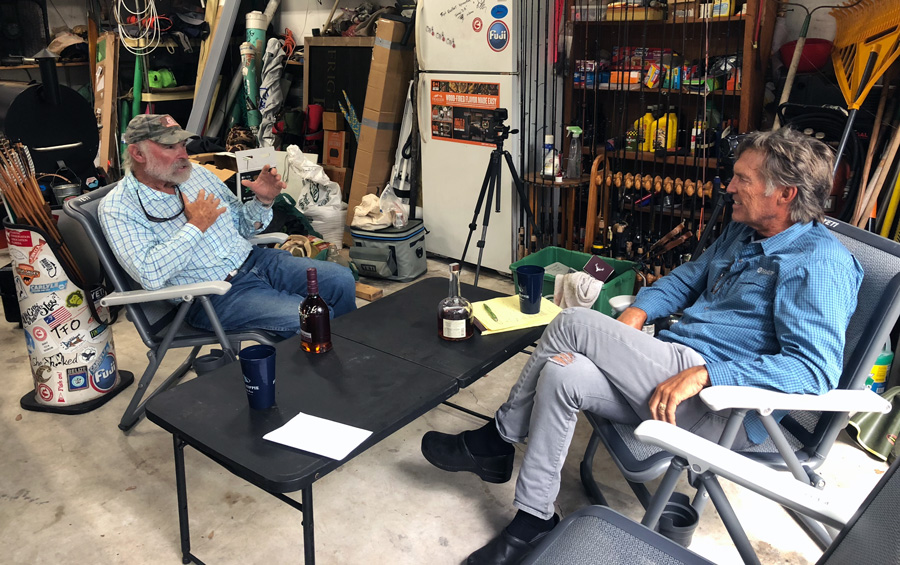by Andy Mill and Nicky Mill
Editor’s note: These excerpts are transcribed from Mill House Podcast episodes. They’ve been lightly edited for brevity and clarity. Andy Mill has added recent reflections on the clips that are signified by italicized text.
Tackle was barbaric and fish were plentiful. Before GPS and sonar, navigation and exploration was about timing with speed and compasses. What was the evolution like for fishing sophistication?
Our history is told through decades of ageless, weathered anglers and guides who dedicated their lives to the pursuit of gamefish far and wide. Their quests and stories are riveting and compelling, instructive to those of us interested to know where we’ve come from and how we arrived where we are today.
If these stories are not told and documented, and if the emotion that accompanies them is not captured on camera, our heroes one day may only be remembered by name, their stories eventually lost with the trade winds.
Archiving our giants is our mission. For the rest of time, generations to come will have a chance to listen and see their forefathers and icons. Our goal at Mill House is to preserve these historical people and the lives they’ve led.
Included here are examples of two of our sport’s greatest statesmen, Flip Pallot and Steve Huff, speaking about when life gets closer to the finish line, a firsthand account of how weighted permit flies came into existence, and also how epoxy flies came to be. We also include moments from our time with Billy Knowles. We thought it would be valuable to share these snapshots as moments in time when a reflection made becomes a legacy for the ages.
From the Mill House Podcast interview with Flip Pallot
Andy: When I called you recently, I asked, “What are you doing, what’s happening?” You said, “I’m sitting in my Yeti chair looking at my backyard, looking at the woods, having a cocktail, trying to figure out what kind of mischief I can get into tomorrow.” What’s your life like now?
Flip: I sharpen a lot of things—hooks, arrows, and bullet points. I’m always happiest when I’m sharpening something or cleaning something.
Andy: I spoke to some of your buddies, great friends, prior to coming up here and they all agreed you’re the ultimate outdoorsman.
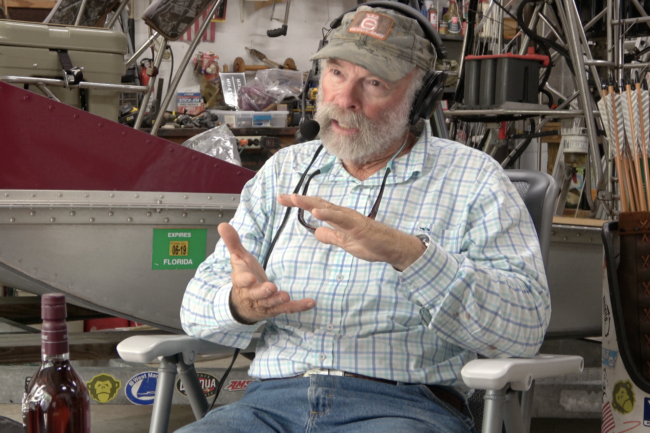 Flip: Well, I don’t know about that … but it certainly calls to me … always has. I never had an interest in sports, never knew who the biggest hitters were. It was never part of my stream of consciousness. I remember more than anything else sitting in elementary school classes looking out the window at the birds and wishing I was out there. School was always terribly difficult for me, not because of the school; it was because I didn’t want to be there, and I finished school because my parents wanted me to. It meant a lot to them. I wish I had those years in college back and do something really cool with them.
Flip: Well, I don’t know about that … but it certainly calls to me … always has. I never had an interest in sports, never knew who the biggest hitters were. It was never part of my stream of consciousness. I remember more than anything else sitting in elementary school classes looking out the window at the birds and wishing I was out there. School was always terribly difficult for me, not because of the school; it was because I didn’t want to be there, and I finished school because my parents wanted me to. It meant a lot to them. I wish I had those years in college back and do something really cool with them.
Andy: Your number-one rule, you’ve said, is to follow your heart. It appears as if you’ve done that now.
Flip: I have with the exception of a few little detours that were important to people that were important to me, family. And so I spent some misguided years working in corporate situations which was like elementary school. I’d look out the window and wish I was out there, and then at some point I came to the full and certain realization life has a finish line and I was going backwards.
Andy: You know, I think, too, Flip, that we all go through those early years when we didn’t really understand who we were, and what our voices were saying, what our heart was saying. Are you listening to your conscience or your heart, but we’re not really sure until you get to the point with some experience and mileage. We all went through those years; it was painful but there was no way out, because we didn’t know the way out.
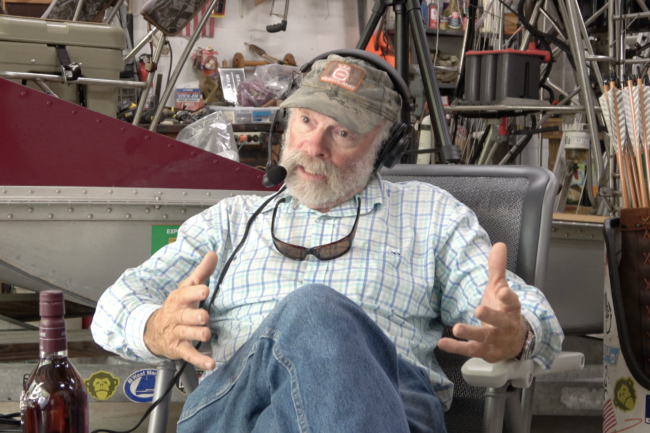 Flip: Exactly right! You have to find that, and there’s a price to pay for that, as there should be. But when you break through the veil, clarity exists. You realize this is what I was made for, this is where I belong and this is where I’ll stay to the finish line. And, just along those lines there is a point at which you clearly realize that you’re closer to the end than you are to the beginning. And so then every moment becomes precious. I mean, sometimes I’ll wake up in the morning and look at the clock and say what am I doing here? I could be doing something right now. And you realize there are only so many moments left, I should say so many vital moments left, and by vital I mean those moments you could spend on a poling tower poling, pushing a skiff into the wind. That comes to an end. How many moments are left that you could walk up a hillside at 9 or 10,000 feet and do your thing there? Those moments come to an end. And I don’t look forward to the time when all I can do is sit around and reflect and remember, I really don’t look forward to that. I look forward to to those vital moments that I just described, and many other things as well. You know what I’m talking about. It was so clear to me this past year when we lost Lefty, and I remember because I spent so much time with Lefty, and I remember when he couldn’t pole any more, and I remember when he couldn’t stand on the front deck of a skiff anymore. And I remember how sad … it wasn’t sad for him; he seemed to deal with it marvelously. It was sad for me because when vitality goes, you’re at the end of the trail.”
Flip: Exactly right! You have to find that, and there’s a price to pay for that, as there should be. But when you break through the veil, clarity exists. You realize this is what I was made for, this is where I belong and this is where I’ll stay to the finish line. And, just along those lines there is a point at which you clearly realize that you’re closer to the end than you are to the beginning. And so then every moment becomes precious. I mean, sometimes I’ll wake up in the morning and look at the clock and say what am I doing here? I could be doing something right now. And you realize there are only so many moments left, I should say so many vital moments left, and by vital I mean those moments you could spend on a poling tower poling, pushing a skiff into the wind. That comes to an end. How many moments are left that you could walk up a hillside at 9 or 10,000 feet and do your thing there? Those moments come to an end. And I don’t look forward to the time when all I can do is sit around and reflect and remember, I really don’t look forward to that. I look forward to to those vital moments that I just described, and many other things as well. You know what I’m talking about. It was so clear to me this past year when we lost Lefty, and I remember because I spent so much time with Lefty, and I remember when he couldn’t pole any more, and I remember when he couldn’t stand on the front deck of a skiff anymore. And I remember how sad … it wasn’t sad for him; he seemed to deal with it marvelously. It was sad for me because when vitality goes, you’re at the end of the trail.”
For me, closing in on 70 with a worn-out body makes it harder to stay in the game. When Pallot spoke of being at 9,000 and 10,000 feet, I knew he was directing that statement to me, knowing that’s where I live in the fall chasing elk. Since then, I dove back into a weight room and onto my bike. I want to still be successful at the things I love. Pallot’s voice hit me right between the eyes. But he’s telling us all to continue doing the things we love, the things we’ll be talking about for the rest of time. Take that fishing trip you always wanted to take. Keep skiing, rafting, hiking, and loving life to its fullest. Spend time with family members, grandkids. You can be tired when you’re dead. Do something this weekend so spectacular you won’t sleep all week. That’s a vital moment.
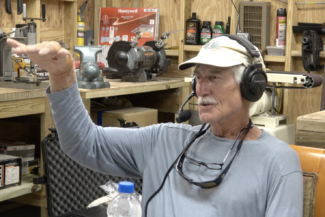
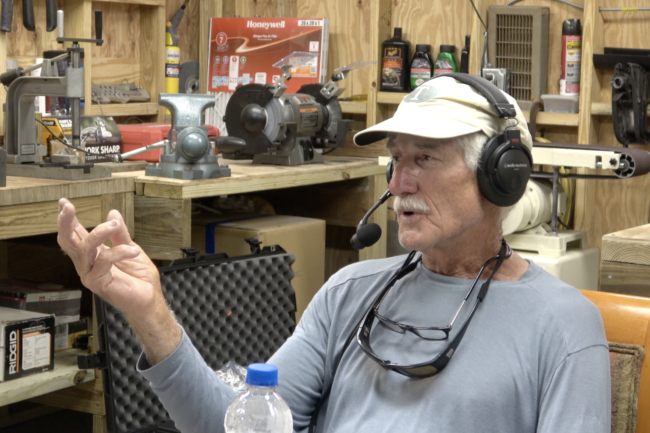
From the Mill House Podcast interview with Steve Huff
Andy: Tell me about those early years of permit fishing west of Key West with you and Del Brown.
Steve: Actually, I learned about permit fishing on Del Brown’s money. So he called me in 1980. He wanted to target permit and fish for permit a lot, and I’d done a lot of permit fishing, but had only caught 15 or 20 fish on fly so this was a learning experience … and we were using lots of different kinds of flies. Del was quite an innovator of flies. He was using other people’s ideas as well, so it wasn’t Del’s exclusively. There were a lot of guys trying to catch these things more frequently, but for whatever reason we started to catch a lot of permit and more permit than anyone had ever dreamed of catching. It was like if you caught a permit in your life it was a big deal. We had countless days when we caught five or six. Sandy (Sandy Moret) caught seven with me one day. That was the best permit fishing I’ve ever had, but also how the fish were getting in a feeding mode. Sometimes they were eating crabs off the surface like a dry fly. Basically, you could see them coming down a channel eating flies off the surface. It’s really cool, and that’s a caught fish when you get a fly in front of that thing. The right kind of fly, something that floats, quiver it, don’t strip it, shake it, cause these things are just coming down … they’re dead meat. The coolest permit strike I ever saw, I was with Charlie Causey, and we were going down this edge of a channel and the tide had fallen out, and we had on one of these floating flies looking for one of these cruising permit taking crabs and we weren’t seeing any. And this permit tailed in this little alcove maybe a foot or so deep, feeding on the bottom, you know. And we had the wrong kind of fly on, and he threw that floating fly over there and it drifted over this fish, and the fish had his head down and he looked up and saw this fly, and he was trying to get his head up to the surface but his tail was hitting on the bottom. He couldn’t get the fly and swam off into the channel, and Charlie said, “Goddamn, man, I thought he was going to bite that thing!” And I said, “Watch this.” And this fish went out into the channel, got a head of steam, and lunged up onto the flat and took the fly off the surface. His head was completely out of the water, like a 25-pound fish. So it makes your hair stand on end to see something like that.
Andy: Was there point in time with permit fishing when you got over the hump? Was it a fly design or you just understanding the dynamics of permit fishing?
Steve: So I could go through an entire talk about the evolution of permit flies, but nobody was putting weight in flies back then for permit. You know Nat Ragland came up with a little fly that had glass eyes on it, which was essentially weight. It had glass eyes on a piece of wire. Nat had somebody, a guy by the name of Bill Levy, catch a couple of permit on this fly. So I said, “Holy shit! We have to put eyes on our flies.” I’ll tell you where the epoxy fly came from. I was looking for eyes, because all of a sudden I knew that eyes were the deal, right? So my wife had some shelf paper in the drawers in our kitchen that had daisies on it, but the center of the daisy was basically an eye, right? So I cut the centers out and it’s got sticky paper, and I tried to stick them on and they wouldn’t stick on, you know? So I made this chenille body and I took some epoxy glue and I tried to stick these things on which made a mess. So I said, “Screw it! I’m just gonna cover the whole head of this thing with epoxy.” So that’s where the epoxy fly came from. Harry Spear came over a couple days later. I think we caught a permit on it because there was more weight, it added more weight. Screw the eyes. The eyes didn’t mean a damn thing. It was about the weight. So then we started adding more weight. The epoxy fly had its day and we started putting on little barbell eyes to get the fly down. I think the real thing was the right amount of weight, because sometimes they’re in shallow and sometimes they’re deeper and sometimes they’re in 4 feet of water along the edge of a channel and you can see them down there mudding, and you need something that gets down there, because they won’t see anything up there, you know? But that’s how the epoxy fly got started.
The epoxy fly, as Steve said, “Had its day.” But the way Steve layered the transition to the epoxy fly and ultimately fly weight is possibly the most important transition in all of shallow saltwater fly design. In another Mill House episode, Michael Guerin said the inventor of weighting flies was something on the order of a genius. Well, we don’t call Steve Huff the “God of Guides” for nothing. This story is one of a million pertaining to Huff’s creativity throughout 50 years of guiding.
From the Mill House Podcast with Billy Knowles
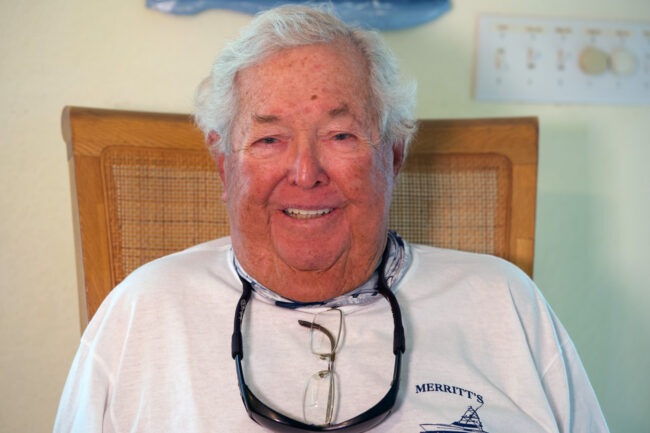 Andy: Let’s talk about Homosassa, because you were there with Carl (Carl Navarre), right?
Andy: Let’s talk about Homosassa, because you were there with Carl (Carl Navarre), right?
Billy: No, I went there the first year in ’71 with Jimmy Lopez. The first morning out, we were the first boat down the river, and we got down to just before Chassahowitzka Point. I mean the tripod. He said, “Maybe there’s a few fish right here. Let’s stop and take a look.” And I shut down. We were in his boat, no electrics, strictly pole, and I was standing on the back of the boat and pushing around some. I see a fish roll. I said, “Jimmy, stand up. A fish just rolled and there might be more with him.” He starts shaking, and I said, “Hurry up!” I said, “Five or six fish just rolled.” He’s still shaking, and I said, “Forget it.” And he said, “Why?” I said, “There’s more damn fish here than I can count. He said, “You’re serious?” I said, “Yeah, it’s a big daisy chain.” Andy, when the sun came up, we weren’t outside the daisy chain throwing in, we were inside throwing out. That’s how big the school was. And he said, “How many fish do you think’s here?” I said, “I don’t know—1,000, 1,500, 2,000. I have no idea.” That day we caught seven and wouldn’t say how many we jumped. But we did catch seven. We were there for ten days. We ended up catching 77 fish in ten days. On the tenth day we never caught a fish. We hooked a fish in the morning about 7 a.m. and we fought that fish till a little after 12. The fish was way past two (200 pounds). He said, “We got to get a shot with the gaff.” I said, “You fight the fish. Let me worry about the gaff.” So not having electrics I had to pole outside of the fish to get up wind of him so the wind could blow me down on him. So I poled outside of the fish, laid the pole down real quiet, picked up the gaff, and the fish turned around and blew the fly right back in his face. He got so mad he threw the fly rod and reel down in the boat, bent the reel all to hell, lowered the motor down, cranked up, and we came in. And I said, “You’re a real sport, aren’t you?” He said to me, “Bring the boat back to Islamorada. I’m flying home.” Now, he had his plane there then. I said, “Whatever you want.” That was my last year with him.
Billy Knowles died January 4th, leaving a profound hole in the collective heart of Islamorada, Florida, where his family homesteaded in the 19th century. At 81, he was still on his tower chasing fish daily. He was one of the first skiff guides. He started fishing offshore as a youngster and over time became one of the planet’s best bonefish guides, winning some of the biggest tournaments on multiple occasions. Billy’s love for his fellow man was prevalent over his entire life, and deep friendships resulted from it. Considered the “Mayor of Islamorada” and a father figure to all, his was the voice of reason. Over the years he fished with Ernest Hemingway, President Herbert Hoover, President George H.W. Bush, and Ted Williams. The term legend often gets thrown around too casually, but Billy Knowles was the real deal, and even “legend” falls short when describing Billy. He was as big as they get in every way, Rest in peace, Billy. We miss you terribly, son.
If you’d like to hear more stories from fishing legends such as Chico Fernandez, Stu Apte, Al Pflueger Jr., and Mark Sosin, check out Mill House Podcast on any podcast app, or watch on YouTube.

